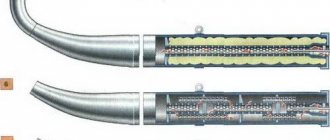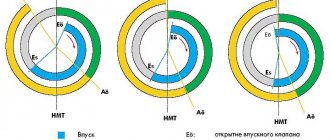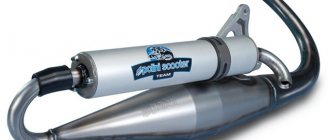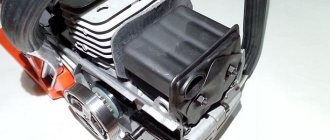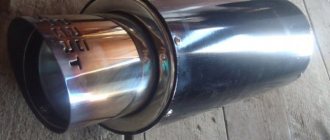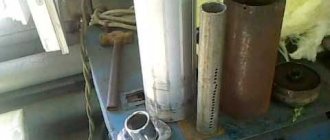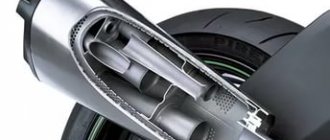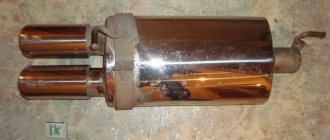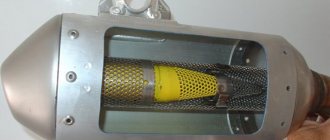Our qualified car service center “Leha Exhaust” provides full service of exhaust systems of motorcycles such as: Harley Davidson, Suzuki, Yamaha, Honda, Kawasaki, KTM, Husqvarna
Manufacturing of exhaust systems for motorcycles in Moscow
We will manufacture and install a custom exhaust on a motorcycle
Motorcycle exhaust system tuning. Photos before work began
Photo after tuning. Muffler - our client's choice
Stainless steel motorcycle exhaust system
We will make an exhaust for a motorcycle in Moscow at a low price
Tuning the exhaust system of a motorcycle in Moscow - car service "Leha Exhaust". Come!
You can see even more photos of exhaust systems in our gallery
Page navigation:
Motorcycle exhaust services
Motorcycle exhaust problems
Motorcycle exhaust system tuning
Services
We provide the widest range of services in Moscow for motorcycle exhaust systems
- Manufacturing and selection of exhaust manifolds
- Exhaust Sound Adjustment
- Direct flow installation
- Replacing or removing the catalyst
- Muffler replacement, cleaning and repair
- Manufacturing of exhaust systems according to individual projects
Most often, our customers turn to us to replace stock elements with high-quality Akrapovic exhaust system components, of which we are the official distributor.
Does forward flow make it noticeable on the road?
It is impossible to give a definite answer to this question. Several important factors influence whether motorists can hear you:
- Speed. If you’re racing 150 around the city on a sportbike and fly into an intersection, suddenly jumping out from behind the cars, no one will have time to hear you. Such racers often find themselves in the side door of a turning car before the sound reaches the driver and gives him time to react;
- If you are flying with your forward flow, overtaking the flow and playing “checkers”, in the hope that the motorists driving ahead will hear your roar and refuse to change lanes from lane to lane - slow down. Otherwise, you will catch up with the car before the sound of your exhaust reaches the driver, and he may want to maneuver, having no idea that a biker will be nearby at that moment. In most cases, the roar of the engine in the car will only be heard when the pilot of the two-wheeled rocket has already flown far ahead;
- Vehicle type. It’s one thing to drive in an old Zhiguli or even a cheap foreign car, in which you can hear everything that rumbles on the road. And it’s completely different – in a maximally soundproofed premium jeep. In such a machine, your forward flow will go unnoticed;
- Music. If the car's speakers are turned on at full power, the driver won't care about your exhaust.
Exhaust functions on a motorcycle. Problems and solutions.
In modern motorcycle society, there is a stereotype that the exhaust is an opportunity to customize the sound. This is partly true, but let’s not forget that the most important function of the exhaust system is to remove engine exhaust gases, as well as cool the exhaust gases, use the pressure pulsations generated at each power stroke, reduce noise levels and be environmentally friendly.
The main problem that motorcycle owners face is the backflow of exhaust gases. During operation of a motor vehicle, the engine faces high loads and extreme temperatures. During the release of gases, high and low pressure waves are formed in the exhaust system, which allow the exhaust gases to escape and prevent the fresh mixture from flowing out through the exhaust channel. As a rule, two-stroke engines are more sensitive to backflow.
In order for the motorcycle engine to operate smoothly, it is necessary to correctly calculate the length of each exhaust system pipe, starting from the exhaust manifold.
Best passive safety
When will forward flow really be noticeable? Only if the motorcyclist does not violate or exceed the speed limit. A “pot-bellied” cruiser with a loud bass exhaust, slowly cruising in a row or approaching an intersection, will be noticeable to everyone. Also when overtaking, it is important not just to suddenly fly past unsuspecting motorists, but to slowly and sedately drive around them, identifying yourself in advance. And when you need to attract attention, it is better to use the horn rather than the gas. This way you will only irritate the people around you, including pedestrians.
But the best passive safety is still increased visual visibility. Bright clothes, a white or acid-colored helmet, reflective elements on equipment, high-beam headlights during the day - this is what works much better than any forward flow.
Motorcycle exhaust system tuning
Customers who contact us about tuning their iron horse want to increase engine power. We can do this in several ways:
- Installation of elements that weigh less than stock. Most often, such elements are made of carbon fiber. They can withstand the highest loads for a long time and are of reference quality. Their main disadvantage is their high price.
- Removing the catalyst. This is fraught with the appearance of a strong exhaust odor, however, it increases engine power and significantly reduces backflow.
- Comprehensive exhaust system replacement. Lightening, adjusting the sound, increasing the diameter of the pipe - all this will help your motorcycle be the first in any race!
- Optimization of muffler characteristics. Our clients often come to us with the problem of setting up sound. Experienced craftsmen can easily cope with this task by replacing the muffler.
Since we are official distributors of the famous brands Akrapovic, MagnaFlow, Gibson, Brospeed, Dynomax, Ractive, Mozart, we will be happy to give you a guarantee from the manufacturer and for our work. We are waiting for you for a free consultation at the address: Moscow, Sokolnichesky Val 1, cor. 1 or you can ask any questions you are interested in by calling +7(495)-142-43-27
Motorcycle exhaust - photo, video, Instagram
Also, you can read Mini catalyst reviews
MY MOTORCYCLE
Probably every biker faces the temptation to tune his motorcycle. Someone changes the appearance, someone does something with the engine, someone else came up with something new. You can improve almost everything on a bike, the main thing is that you have enough imagination and possibilities. They often like to change or modify exhausts: they want more power. louder sound, etc. It is in this post that we will talk specifically about exhaust tuning.
It’s tempting to replace the standard muffler on a sportbike with a tuning one: in addition to the additional horsepower, you’ll get the “correct” sound. Who doesn’t like to roar through the streets so that everyone pays attention? Moreover, the traffic police pays little attention to this. Try to catch up)))))))
A little about the design and operation of the muffler
On modern four-stroke motorcycles, two types of mufflers are used - sound-absorbing ( a ) and resonator ( b ). There is also a combined system, but little can be said about their widespread use! Standard motorcycle mufflers are of the resonator type. The design of such a “Pipe” resembles a labyrinth. If you cut it open, you will find a series of compartments inside, connected by tubes - the so-called “flutes”. The size of the “flute” is such that the exhaust gases can easily leave the chamber, and the sound wave will only partially pass through. This process is repeated in each compartment, and at the output of the sound wave there remains only a characteristic “whispering” - a faint shadow of the wild roar that entered the muffler from the engine. Of course, such a system is complex and leads to loss of power due to the many obstacles that the exhaust gases have to overcome. But it has its advantages. Each time the gas hits the wall of the compartment, a secondary wave is formed - reflected, it moves in the opposite direction. Careful calculation of the labyrinth configuration makes it possible to combine this process with the moment of closing the exhaust valve, and then the secondary wave will “push” the unburnt mixture back into the combustion chamber. This effect is used to increase mid-range power. However, due to the complexity of the design, resonator mufflers are very expensive - their cost ranges from 600 to 800 dollars apiece. Therefore, most aftermarket mufflers are the sound-absorbing type.
Sound-absorbing pipe - combines relative cheapness and undoubted efficiency.
Its design is as simple as an Alpine horn: one large “flute” with many holes passes through the muffler body. The space between it and the body is filled with muffling padding resembling fiberglass. Entering the muffler, the gases are carried away in a straight line, and the sound wave, expanding, is partially absorbed by the packing. Its volume changes slightly. Therefore, despite its name, a sound-absorbing muffler is a sure-fire way to tune the “voice” of both a solid chopper and a souped-up sportbike. A booming roar or a characteristic racing howl obtained after installing such a “pipe” will notify you of your approach a couple of kilometers away. In addition, breathing deeply, the motorcycle gains several additional “horses”, albeit in a narrow rev range. Unlike standard ones, sound-absorbing mufflers require maintenance. This is expressed in regular replacement of the packing, since after several million sonic booms it thickens and loses its properties. Although to some this may seem like another advantage - the motorcycle begins to “scream” even more colorfully. And the indisputable disadvantage of such a “pipe” is the lack of a controlled secondary wave due to the lack of internal partitions. As a result, there may be a loss of power "in the middle of the tachometer". In both “pipes” another type of sound wave operates - low pressure. It occurs when sound reaches the muffler outlet and then travels to the engine. If it comes to the exhaust valve at the moment it opens, a reduced pressure is created at the outlet, and the contents of the combustion chamber fly out with even more enthusiasm.
What can be done?
Replacing just the "pipe" basically improves the sound and appearance of the bike. The power increases slightly - by two percent. If you want a noticeable increase, change the pipes as well, then your engine herd will grow by five to seven percent. If the manufacturers of some “super-duper” release promise more, be careful: no one has ever managed to cross this line. What does replacing pipes give?
The fact is that both standard and tuning pants use the same effect. The engine cylinders operate unevenly relative to each other, the exhaust from each moves to the muffler as if alone, creating a low-pressure zone behind it. By carefully selecting the pipes, you can calculate their length so that portions of gases from different cylinders will follow one after another like the teeth of a “zipper” on your overalls, falling exactly into these very zones. As a result, the speed of the exhaust gases increases, the combustion chamber is cleaned faster, and engine power increases. However, the standard pipes are designed so that the engine provides both stable traction at medium speeds and “pickup” at high speeds. The creators of tuning “pants” are concerned only with peak power and without regret sacrifice the width of the range in which the engine “pulls”. By changing the configuration of the pipes, they achieve maximum output from the engine within 200-300 rpm, which is ideal for advanced racers who are able to keep the tachometer needle at exactly 8 at this point. Ordinary mortals are unlikely to be able to estimate an increase of five horses “somewhere in the region of 8200.” Tuning pants not only increase power. Convenience is another advantage. Unlike standard ones, they are collapsible, on springs. If you replace the pipes, you don’t have to replace them entirely - just remove the damaged section and install a new one.
Which muffler should you choose?
It all depends on why you need it!?
- If for “rumble” on the streets, the option is a sound-absorbing muffler made of stainless steel or aluminum. It looks smart, screams loudly and the engine “breathes”. And it costs less than others.
- For those who want to really improve the performance characteristics of their pet, there are two other types of mufflers.
- For those who practice active driving, there are titanium “pipes”, the main advantage of which is durability. By installing them, you will significantly reduce the risk of damaging your mufflers when meeting asphalt.
Titanium mufflers
4. “Speed racers” who count every kilogram will probably choose a carbon fiber muffler, which, in addition to the advantages common to tuning “pipes,” is much lighter than the original one. However, these toys significantly empty your wallet.
Well, complete exhaust systems, which embody all the possible advantages of tuning, are intended for truly advanced superbikers or citizens who do not have financial problems at all. The cost of such “things” is quite high for a simple biker. And definitely not in national currency.
And finally, advice: do not try to tune the exhaust by gutting the original muffler. The sound will indeed become loud, but it will not be singing, but shouting. It can't be compared to a real tuning voice. Unless of course you are “Kulibin”. ……
Making a direct-flow muffler from scratch
You can make such a muffler from scratch. This will be a completely new version made from several components. The difficulty of this operation, called tuning from scratch, lies in finding the diagram of the exhaust system of a particular moped.
Tools and materials
In this case, again, you need to prepare the necessary tools and materials.
- Purchase in a store or find two pipes with a diameter of 33 mm;
- Buy plexiglass;
- Bolts M8 and M3;
- Prepare glue and nails;
- Welding machine;
- Needles;
- Hacksaw for metal.
Let's start assembling
First of all, you need to cut 18 cm from one of the pipes. It is recommended to carefully process the place in the cut with a needle file. From the second pipe we cut a circle with a diameter of 1.5 cm. We process it using the method described above. Glue the cut out circle in the section of the first pipe. We cut off another piece of pipe, 18 cm long. We make many holes in it. This can also be done with a sharp nail.
We connect all the parts using a welding machine. We fill the cavity formed at the junction of two pieces of pipe with mineral wool. We wrap the finished product with a special fire-resistant material. The homemade muffler is ready. To install it, you will need to attach the element to the scooter body mount.
Making a muffler mounting element
From plexiglass, which is indispensable in this matter due to its strength and easy paintability, we cut out a special type of ring, the edges of which can be bent outward by 180 degrees. We attach the resulting circles with serifs to the moped using the required bolts. We polish the muffler using sandpaper. To be sure, the joints between the homemade product and the moped body will need to be lubricated.
Homemade muffler for moped disassembled
If homemade production causes certain difficulties, you can find a lot of models of mufflers already in finished form. They are usually inexpensive. On the other hand, only a homemade version can provide the ideally expected option.
Muffler conversion
As a rule, many craftsmen not only assemble a muffler, but remake a standard one. This makes it possible to spend less time and get a more acceptable option.
Tools and materials
Before you start tuning, you need to prepare the necessary tools. In this case, the following components will be needed:
- Welding machine, preferably with different operating modes;
- Pipe of appropriate size and diameter;
- Bulgarian;
- Several metal brushes for washing dishes.
Let's start tuning
First we dismantle the muffler. Then we take a grinder and cut out a piece of metal on top of the muffler. With this cut it will be much easier to work with the muffler. You should almost completely cut out the top part. After this, it is necessary to clean the entire internal space of the muffler, dismantling the cut-away elements.
It's time to work with the piece of pipe that we have prepared. Using a powerful drill or welding, we make many holes in the pipe. We place the pipe in the section of the standard muffler. We select in advance a pipe of such a diameter that it fits inside the standard one. It is desirable that the pipe be without any obvious flaws and perfectly straight.
Straight-through muffler in the process of assembly
The space in the cut that remains between the two pipes must be filled with metal pipe cleaners or similar materials. We weld the top of the pipe as it was. We reinstall all structural elements that were dismantled during the process.
As a result of the tuning, we will get a forward flow muffler that provides the desired result. The massive and rich roar of the engine, as well as the increase in power of the moped, will be evidence that everything was successful.
Cleaning the muffler
The cleanliness of the muffler affects the power of the moped
Before you start changing anything in the exhaust system, I would like to give one piece of advice. The power of the scooter is directly affected by the cleanliness of the muffler. If it were possible to see the exhaust in a cross-section of the muffler, the owner of the scooter would be very surprised. After a certain mileage, the scooter's dynamics decrease, and owners begin to look for the reasons for this, finding them in a complete rework of the standard muffler or its replacement.
The reason for the loss of power, meanwhile, may be hidden in the condition of the engine itself. This will help determine the specialist you should contact before tuning. But the most common cause of loss of dynamics is soot that clogs the muffler. In this case, it is recommended to carry out cleaning in three ways.
First method: mechanical
It involves cleaning the muffler section (it is done with a grinder). The inside of the muffler is cleaned of soot using a wire or cable. The section in the section is closed by welding.
Second method: chemical
It involves pouring water with some kind of cleaner into the muffler. For example, caustic soda is suitable for this purpose. This cleaning has the advantage that the appearance of the muffler will not be affected in any way.
Third method: heat treatment
The muffler is heated either on the scooter with a blowtorch, or dismantled in an oven or on a grill. It will be necessary to repaint the muffler only after it has cooled.
